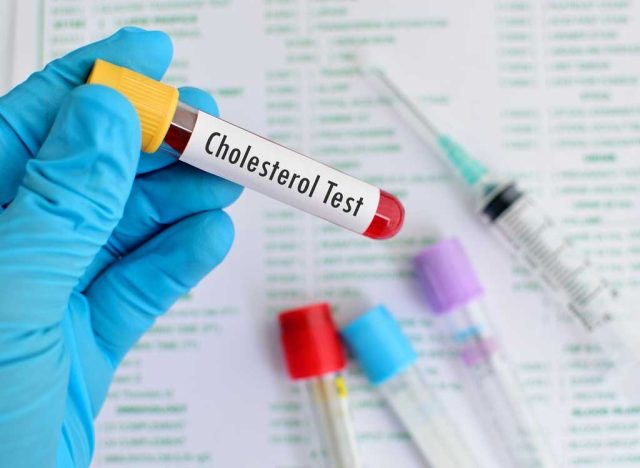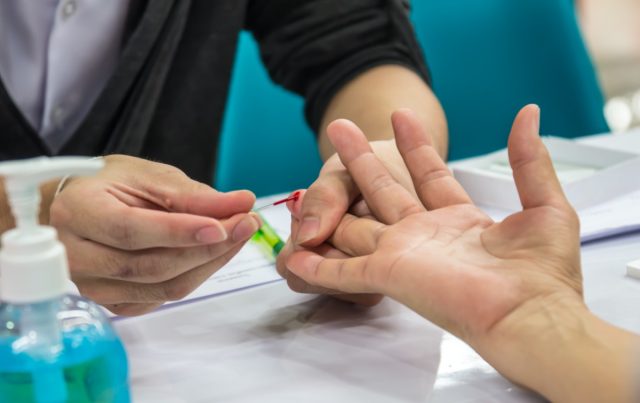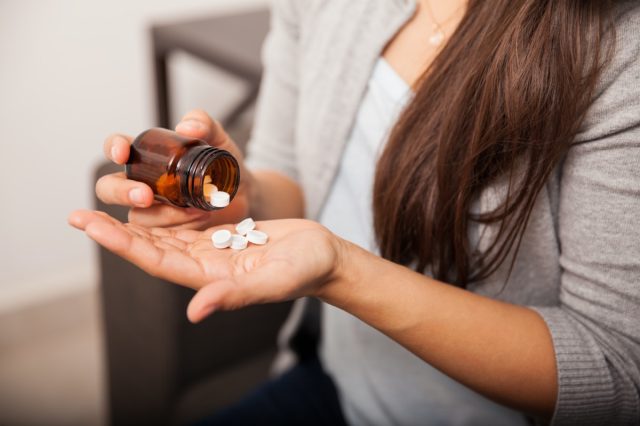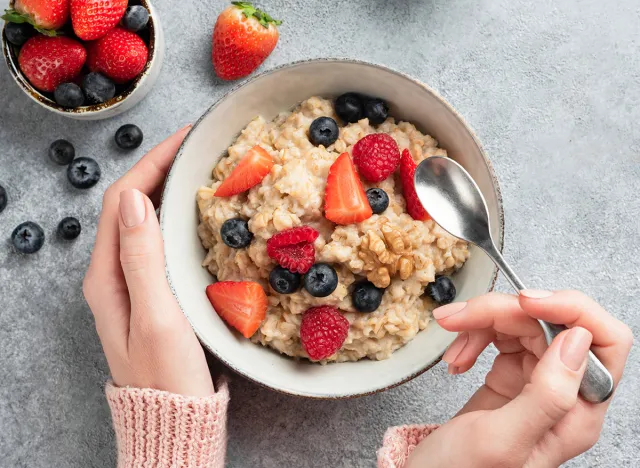High cholesterol could be secretly hurting you. Dr Nick Fuller from the University of Sydney and the founder of the Interval Weight Loss program tells Eat This, Not That! Health, “It is the number one contributor to heart disease and heart attacks. Someone has a heart attack every 40 seconds, which leads to death in many cases,” according to the Centers for Disease Control and Prevention, “Nearly 94 million U.S. adults age 20 or older have total cholesterol levels higher than 200 mg/dL. Twenty-eight million adults in the United States have total cholesterol levels higher than 240 mg/dL” That’s a staggering number of Americans who are living with high cholesterol, a condition that can be inherited, but is mostly caused by poor lifestyle choices, the Mayo Clinic states. ETNT! Health spoke with several experts who explain exactly what cholesterol is, what causes high cholesterol and how to get normal cholesterol, which is under 200 mg/dl for adults. Read on—and to ensure your health and the health of others, don’t miss these Sure Signs You’ve Already Had COVID.


Dr. Jorge Luis Green, the board-certified bariatric and general surgeon for Renew Bariatrics, explains, “Cholesterol is a waxy, fat-like substance that’s found in all the cells of your body. Your body needs some cholesterol to work properly because it helps it make new healthy cells, produce hormones and Vitamin D, and digest food.” Amy Lippert, a Functional Nutritionist with Almond Milk and Cookies adds, “Cholesterol is a compound that is synthesized in the liver and it is important in building and maintaining cell membranes, is converted in the liver to bile, and it is the precursor to vitamin D and all steroid hormones such as sex hormones and cortisol.”


Rachel Fine, a Registered Dietitian Nutritionist with To The Pointe Nutrition says, “The different types of cholesterol represent the different lipoproteins in the blood. The chemical composition of these lipoproteins is what determines whether they are considered ‘LDL or low density lipoprotein’ or ‘HDL- high density lipoprotein.’ The physical densities of these lipoproteins depend on several properties, but one is the specific ratio of fats (or triglycerides) to protein.”


Fine explains, “Low density lipoproteins (LDL) is mainly composed of cholesterol, which is transported through the blood towards tissues. While some can be used to build cellular membranes, excess can cause buildup of plaque. High density lipoproteins are composed mainly of protein and involve the reverse of cholesterol transport: moving cholesterol away from tissues and rather towards the liver where it is excreted via bile. LDL is specifically “bad” for us because our body’s cellular lining of blood vessels have LDL receptors, which allow for LDLs to deposit cholesterol there… high concentrations of these deposits build and eventually can lead to atherosclerosis. On the contrary, HDL mediates the reverse cholesterol transport, which reduces the amount of cholesterol deposited in blood vessels and thus reduces the risk of atherosclerosis.”


“Cholesterol comes from both your diet and your liver. If damaged or poorly functioning, the liver can end up making so much cholesterol that can overflood the blood with it,” says Dr. Green. “When this happens, cholesterol can damage the lining of your arteries and form plaque – a thick, hard deposit that can make them narrower and less flexible. This increases your risk for heart disease, stroke, and other problems.”
According to Lippert, “When referencing high cholesterol, we are usually identifying that the low-density lipoprotein (LDL: bad) is too high in comparison to the high-density lipoprotein (HDL: good). Having an imbalance, or too much LDL in the blood is bad because it is the vehicle that carries cholesterol out of the liver and to the body cell, so where there is too much LDL, cholesterol is high. HDL helps to remove excess cholesterol from the body and transports it back to the liver where it can then be detoxified and eliminated. Having too much LDL in the body results in more cholesterol in the blood. Additionally, having too much LDL may lead to a build up in the inside walls of the arteries and can lead to blockages resulting in cardiovascular disease.”


Dr. Green explains, “There are many different causes of high cholesterol, including eating too much unhealthy food, not exercising enough, and even genetics. However, the most common cause is obesity. When someone is obese, they have a higher chance of developing high cholesterol because they are more likely to have a poor diet and be inactive. Additionally, people with high cholesterol often have a family history of the condition.”
Lippert states, “Cholesterol is produced by the body due to a poor diet. Eating foods that contain ultra refined ingredients and trans fats will lead to higher levels of LDL (bad) and lower levels of HDL (good).”


According to Dr. Green, “If you have high cholesterol, there are a few things you can do to help lower it. One is to exercise regularly – at least 30 minutes per day. Exercise helps to burn body fat, which in turn helps to lower cholesterol levels. It also helps to improve the function of the endothelium, the lining of the blood vessels. This can help to prevent blockages from forming and reduce the risk of heart disease.”
Anna Rios, RDN with Healthy Simple Yum adds, “Increase physical activity, especially a combination of cardio and strength/resistance. Exercise stimulates enzymes that help reduce LDL levels in the blood. The cholesterol is then moved to the liver for bile production and is excreted.”
RELATED: Signs You Have Heartburn, Say Physicians


“A healthy diet that includes plenty of fruits, vegetables, and whole grains can help lower cholesterol by reducing the amount of saturated fat and trans fat in the diet,” says Dr. Green. “A healthy diet can also help to maintain a healthy weight, which is also important for reducing cholesterol levels.”
Rios reminds us, “Plant-based proteins have little to no saturated fats. Choosing more plant-based proteins and reducing animal-based proteins will help reduce LDL cholesterol in the blood.”
Lippert says, “Eat a whole food diet: ditch the refined and processed foods and focus on more fresh produce, protein, and whole grains. Remove trans fats from the diet: trans fats, like the ones in fried foods and margarine raise LDL in the body. Eat whole grains like oatmeal, whole wheat bread and shiitake mushrooms: these foods contain a fiber called beta-glucan that helps to reduce LDL.”
RELATED: If You Notice This on Your Body, Have Your Arms Checked


Dr. Green states, “If you have high cholesterol, your doctor may prescribe medication to help lower your levels. There are several different medications available, and each one works in a slightly different way. Some medications work by reducing the amount of cholesterol your body produces, while others help your body get rid of cholesterol more quickly. Your doctor will work with you to find the medication that works best for you.”
RELATED: What Taking Zinc Does For Your Body, Say Experts


Dr. Fuller gives the following suggestions:
- “Switch your cereal to oats. Oats contain a special type of fibre called beta-glucan which removes bad cholesterol from the arteries.
- Cut out the coconut oil. This trendy fad is only increasing your cholesterol level, not decreasing it. Include healthy oils such as olive oil instead.
- Don’t buy into the “cholesterol free” or “low in cholesterol” labeling. These foods may be increasing your cholesterol if they contain trans or saturated fat.”